Swift
Click images for larger view (NB: images are especially large)
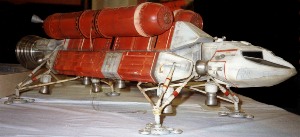 |
The Swift is one of the most impressive spacecraft designs seen in Space: 1999. It featured in only one episode, Brian The Brain and was designed by Ron Burton and built by Martin Bower. The Swift is described as being a support ship on a 1996 "star mission". The other space missions we see have no support spaceships (Phoenix, Ultra Probe, Meta Probe). These other missions were planetary, which would perhaps indicate a need for landing craft like the Swift, whereas the 1996 mission was to another solar system. There was an earlier interstellar ship, the 1987 Voyager, but while that was designed as a manned mission it was in the event a robot ship. An interstellar mission is very ambitious, and this is certainly a large operation, with a mothership (its design is unknown), four support Swifts, and a crew of perhaps twenty or more. Because of the other failures in Earth's space programme, information about the 1996 star mission may have been concealed. When contact was lost no details were released, effectively leaving no trace of yet another disastrous space failure. Hence the Alphans generally do not recognise the craft or remember the mission (Maya has to look it up on the computer). Tony's comment that it is "an old Swift from Earth" may indicate it is obsolete design perhaps heavily modified for deep space operations. This is a larger craft than the Eagle. There is a single large main booster, large storage pods and two top mounted fuel tanks. These indicate its long range capabilities. There are three smaller rockets behind the main booster rocket which may be the original booster configuration (they are roughly the same size as the Eagle engines and would probably be used for normal short range operations). On the other hand, if the main booster is a nuclear thermal engine (NTR; see diagram) as seems likely, the smaller rockets could in fact be the turbine exhaust nozzles (nuclear engines use some of its rocket fuel for cooling the main engine nozzle; the resulting hot bleed gas is later used for powering the fuel pump turbines before being vented). NTR propulsion would provide essentially limitless range as the Swift could use just about any form of liquid as rocket fuel (e.g. water or liquid carbon dioxide, methane or hydrogen), i.e. the ship would land on a planet and refill its empty rocket fuel tanks with indigenous propellant before continuing its journey.The limiting factor would then be the nuclear fuel required to heat the reaction propellant as well as provide electrical power. This is presumably the reason why Brian is so anxious to transfer "nuclear fuel" from the mothership. The top fuel tanks also have two smaller rockets pointed at angles for manoeuvrability. There four large VTOL rockets suspended under the ship, as three centrally aligned vertical thrusters. The four legs suggest it is designed for planetary or lunar landings, although the nonaerodynamic shape, especially the legs, would be a problem in a thicker atmosphere. The Swift may mitigate this problem with anti-gravity technology (like the Eagles). The command module is clearly detachable and features two relatively large rear boosters; these are clearly more powerful than the Eagle or Ultra Probe command module. Additionally it has four attitude control rocket clusters, on the sides and on top. The Swift command module is clearly designed for extended and flexible independent operation. The entire spacecraft seems to be highly modular; it is possible that the command module in fact mainly serves as a rescue craft or small excursion vehicle and that the main Swift vehicle is controlled from its internal "Pilot Section" cockpit which does not have viewports (the Starcruiser is highly similar in this regard). Entry to the Swift is by side hatches forward of the centre of the ship. The interior set, including the labelled "Swift pilot section", would clearly fit fully within the main body of the ship. The actual command module must be some distance further along, along a relatively narrow corridor and looks to be at a higher floor level. Possibly the Swift was modified for the 1996 operation or subsequently by the crew so that the pilot section was inside the main body of the ship (for one thing, Brian could not climb any steps to reach the command module). |
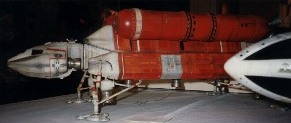 |
|
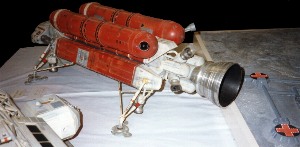 |
|
 |
|
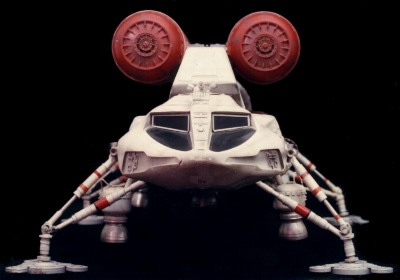 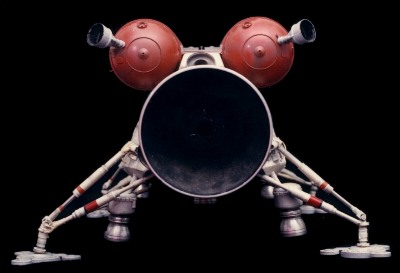 |
|
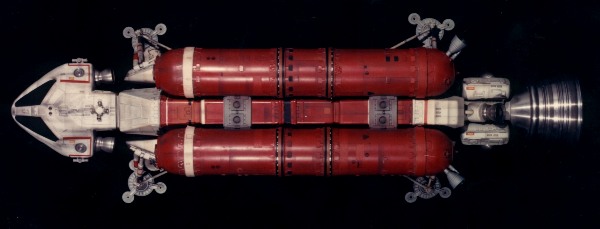 |
|
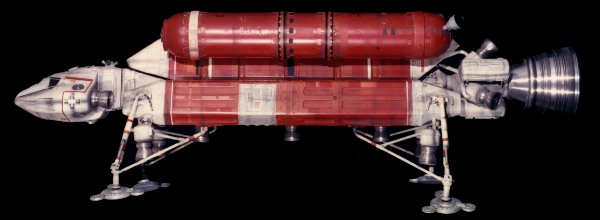 |
|
 |
|
Copyright Martin Willey. Thanks to Marcus Lindroos